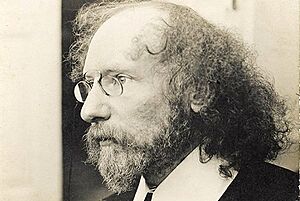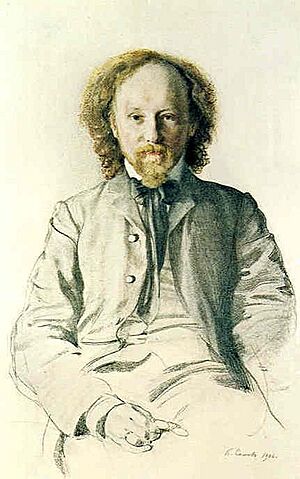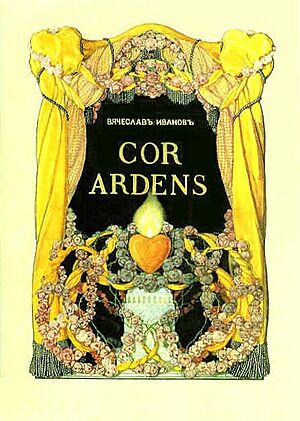Vyacheslav Ivanov (poet) facts for kids
Quick facts for kids
Vyacheslav Ivanov
|
|
|---|---|

Ivanov in 1900
|
|
| Born | Vyacheslav Ivanovich Ivanov 28 February 1866 Moscow, Russian Empire |
| Died | 16 July 1949 (aged 83) Rome, Italy |
| Occupation | poet and playwright |
| Nationality | Russian |
| Alma mater | Moscow State University, Berlin University |
Vyacheslav Ivanovich Ivanov (Russian: Вячесла́в Ива́нович Ива́нов; February 28, 1866 – July 16, 1949) was a famous Russian poet, playwright, and philosopher. He was also a translator and literary critic. He was a very important figure in the Russian Symbolist movement.
Ivanov was born in Moscow. He studied history, philosophy, and ancient languages. He became very interested in the ideas of Friedrich Nietzsche. Later, he moved to St. Petersburg and became a central figure in the literary world.
He hosted a weekly meeting called "On the Tower." Many famous writers and thinkers attended these gatherings. Ivanov helped discover the poet Anna Akhmatova. He also taught and guided others, like the philosopher Nikolai Berdyaev and the Nobel Prize-winning poet Boris Pasternak.
Ivanov had new ideas about theatre. He wanted to make the audience part of the play. He believed theatre could be a powerful way to bring people together. His ideas influenced important theatre directors like Vsevolod Meyerhold.
After the First World War and the October Revolution, Ivanov moved from the Soviet Union to Italy in 1924. In 1926, he joined the Russian Greek Catholic Church. He spent the rest of his life in Rome. He taught at universities there. His students included important religious figures like Bishop Theodore Romzha.
Since his death in 1949, Ivanov's writings have become popular again. His works were banned in his home country for many years. But after the collapse of the Soviet Union in 1991, people rediscovered his work.
Contents
Early Life and Studies
Vyacheslav Ivanov was born in Moscow. His father died when he was five years old. His religious mother raised him in the Russian Orthodox Church. He was a very good student.
He went to Moscow University to study history and philosophy. In 1886, he moved to Berlin University. There, he studied ancient Greek and Roman history, law, and economics. In Germany, he learned about the poetry and philosophy of German Romanticism. He was especially interested in how the ancient Greek worship of Dionysus was connected to the start of Greek theatre.
In 1892, Ivanov studied archaeology in Rome. He finished his doctoral paper there. In 1893, he met Lydia Zinovieva-Annibal, who was a poet and translator. They later married in 1899 in Livorno, Italy.
They lived in Athens and Geneva. They also traveled to Egypt and Palestine. Ivanov often visited Italy to study Renaissance art. His first poems were about the beautiful nature of Lombardy and the Alps. These poems were influenced by old religious poetry.
Around 1900, Ivanov developed his ideas about Rome and the Greek cult of Dionysus. He wrote a book called The Hellenic Religion of the Suffering God (1904). In this book, he explored how ancient Dionysian rituals led to tragedy in theatre. He saw a connection between Nietzsche's ideas and Christian thought.
Ivanov's first collection of poems, Lodestars, came out in 1903. Critics praised it as a new step in Russian Symbolism. His poems were known for their old-fashioned language. Ivanov used quotes from many languages in his work. He also tried to use ancient Greek poetry styles in Russian verse.
The Tower Salon
In 1903, Ivanov gave talks about the cult of Dionysus in Paris. His ideas caught the attention of the poet Valery Bryusov. In 1905, Vyacheslav and Lydia Ivanov returned to St Petersburg. They were very popular there.
They started a literary meeting called "Ivanov Wednesdays." It was better known as "On the Tower" because it was held in their apartment. Their apartment was on the seventh floor and overlooked the gardens of the Tauride Palace.
The meetings often started late, after supper at 2 AM. Many talented people came to discuss ideas. The philosopher Nikolai Berdyaev said Ivanov was a great poet and scholar. He could make any topic interesting.
Nicholas Zernov wrote that Ivanov brought together people with very different views. Christians, skeptics, monarchists, and republicans all came. They discussed religion, philosophy, literature, and politics. They also listened to music and poetry.
"The Tower" became the most popular literary meeting place during the Silver Age of Russian Poetry. Poets like Alexander Blok, philosophers like Nikolai Berdyayev, and artists like Konstantin Somov visited. The Ivanovs had a huge impact on the Russian Symbolist movement.
At the Tower, Ivanov led a change in Russian Symbolism. He moved it away from French Symbolism. He wanted to connect it more to ancient Greek culture and German philosophy. He was especially interested in the ideas of Richard Wagner and Friedrich Nietzsche.
Ivanov wanted to create a new kind of theatre. He called it a "collective action." It would be like ancient religious rituals and medieval plays. He believed theatre could become a spiritual event. He thought it could help people find religious belief again.
He wrote that classical French plays were about ideas. But plays by Calderón were different. They showed how God's plan guided human life. Calderón was a religious Catholic. He combined individual freedom with a deep spiritual view of the world.
Maria Skobtsova, who later became a Russian Orthodox nun, was a frequent guest. Years later, she felt ashamed of the atmosphere at the Tower. She thought the intellectuals there were too separated from ordinary people. She believed they had a lot of culture but were disconnected from the real Russia.
However, scholar Robert Bird had a different view. He said Russian Symbolism was more than just an art movement. It was a way of looking at the world. It tried to give art a spiritual meaning. Symbolists believed that different fields of knowledge were connected. Poetry was linked to painting, music, drama, philosophy, and religion. The discussions at Ivanov's "Tower" showed these connections.

During this time, Ivanov wrote his first play, Tantalus (1905). His second play was Prometheus (1919). Both plays were like ancient Greek tragedies. They used old language and stories from Greek mythology. But his ideas about theatre, even if they were not fully realized, were more influential.
Ivanov suggested creating a new kind of theatre. He wanted it to be like ancient religious rituals. He believed the poet and the audience should be closer. He was inspired by Nietzsche's ideas and Wagner's concept of a "total work of art." Ivanov thought that the mask in theatre could show a universal human experience. He believed that staged myths could help people understand shared suffering.
He rejected traditional theatre where actors pretend. Instead, he wanted real action. He imagined a theatre where the stage and audience were not separate. Actors would mix with the audience. Everyone would wear masks and costumes. They would sing and dance together. This way, everyone would become part of the play. He hoped this would lead to a spiritual change in society.
Some people, like director Meyerhold, liked Ivanov's ideas. They liked the idea of actors and audience mixing. But others were doubtful. The poet Andrei Bely said that social differences could not be erased by masks and costumes. He wondered how a rich lady, a stockbroker, and a worker could all dance together as one. He felt that class differences were too strong for such an artistic idea to work.
Later Life and Emigration
Ivanov's wife, Lydia, died in 1907. This was a very sad time for him. After this, his poetry changed. He became interested in theosophy and spiritualism.
In 1913, Ivanov married Vera Shvarsalon. Their son, Dmitry, was born in 1912. Vera died in 1920 at a young age, which deeply saddened him.
Anna Akhmatova recalled meeting Ivanov in 1910. She read her poems to him at the Tower. She said he would sometimes cry when she read. But later, he would criticize her poems in other literary groups. Akhmatova never forgave him for this.
Akhmatova and other poets later formed the Acmeist movement. This group rejected Ivanov's Symbolism.
By 1910, Russian Symbolism was dividing. One group, led by Ivanov, focused on spiritual goals for art. The other group, led by Valery Bryusov, believed art should not be tied to religious or mystical aims.
In 1910, director Vsevolod Meyerhold staged a play by Calderón in Ivanov's apartment. Many important Russian writers were there.
In 1912, Ivanov met Fr. Leonid Feodorov, a priest of the Russian Greek Catholic Church. Ivanov showed interest in the Catholic Church. He was especially drawn to the Byzantine Rite. However, Feodorov felt Ivanov's interest was more about art and mysticism than deep religious faith.
During a trip to Italy in 1912–13, Ivanov often met with Aurelio Palmieri, a scholar of Eastern Christianity. Ivanov also defended Catholicism in discussions with other thinkers.
After returning to Russia in 1913, Ivanov met art critic Mikhail Gershenzon and philosopher Sergei Bulgakov. He wrote more about his Symbolist ideas. He also started translating works by ancient Greek poets like Sappho and Aeschylus into Russian.
Ivanov continued to influence younger writers. In 1913, Boris Pasternak gave a talk. He echoed Ivanov's ideas, saying that Symbolism could achieve "realism in religion."
Life After 1917
In 1920, Ivanov moved to Baku. He became a professor of ancient languages at the university there. He focused on his scholarly work. He completed a book called Dionysus and Early Dionysianism (published 1923). This book earned him a Ph.D.
The new Marxist-Leninist government in the Soviet Union did not want Ivanov and his family to leave. But with help from his former student Anatoly Lunacharsky, they were finally allowed to emigrate in 1924.
Moving to Italy
From Azerbaijan, Ivanov went to Italy. He first settled in Pavia. He taught Russian literature there from 1926 to 1934. He was then chosen to be a professor at the University of Florence. However, the government of Fascist Italy did not allow him to take the job. In 1934, Ivanov and his family arrived in Rome. He wrote a poem about this move called Regina Viarum.
Ivanov explained why he left Russia. He said he was born free, and the silence in Soviet Russia felt like slavery.
In Italy, Ivanov was known for his wide knowledge. He spoke many European languages. He connected with people who were trying to bring back religious and cultural values.
While teaching at the Pontifical Oriental Institute in Rome, Ivanov and his children formally joined the Russian Greek Catholic Church. This is a branch of the Eastern Catholic Churches.
In 1926, Ivanov said a prayer for Christian unity. He also formally agreed to the Catholic Church's beliefs.
In a 1937 interview, Ivanov said that before the Great Schism, Latin and Byzantine Christianity worked together. He believed the Roman Church could connect with all parts of life. He felt that by joining this Church, he was truly being Orthodox. Scholar Robert Bird said Ivanov saw his conversion as a continuation of his Russian Orthodox faith.
Even though he didn't have a steady income, Ivanov became well-known in Europe by the early 1930s. In 1931, he successfully defended Christianity in a debate against Benedetto Croce. This greatly increased his reputation.
From 1936, Ivanov taught at the Russicum. This was a Catholic school in Rome that trained priests for missionary work. His students included future Bishop Theodore Romzha and Gulag survivors Frs. Walter Ciszek and Pietro Leoni.
Ivanov's lectures on Russian literature were very challenging. Only native Russian speakers or advanced students attended. He gave famous lectures on Dostoevsky's novels. He also read his own Christian poems about the birth of Jesus.
A former student, Gustav Wetter, remembered Ivanov explaining Russian Symbolism. Ivanov said that "Everything ephemeral is only a reflection." He also spoke of moving "From what is real to what is more real." These ideas greatly influenced Wetter.
Ivanov also worked as a translator. He translated Latin texts into Church Slavonic. He translated prayers like the Sacred Heart and the Immaculate Heart.
In Italy, Ivanov wrote essays in German, Italian, and French. He gained admirers like Martin Buber and Charles Du Bos. He continued to write poetry and scholarly works until his death. His later works showed a stronger Christian faith.
Ivanov died in Rome on July 16, 1949. He was buried in the Cimitero Acattolico in Rome. This cemetery is where other famous poets like John Keats and Percy Shelley are buried.
Legacy
After his death, Ivanov's writings continued to be promoted by friends like C.M. Bowra and Sir Isaiah Berlin. An English translation of his book about Dostoevsky was published in 1952. His last book of Russian poetry, Svet vechernii ("The Evening Light"), came out in 1962.
Sir Isaiah Berlin wrote that Russian literature often explored one's place in the world. He noted that movements like Symbolism, led by Ivanov, were important but did not last long as a main force.
Because Ivanov moved to the West, his works were not republished in the Soviet Union for decades. It was difficult to study them. But after the fall of the Soviet Union, people became interested in his work again. His books were republished, and he became the subject of many studies.
One of Ivanov's most widely read works since the fall of Communism is his Russian commentary on the Christian Bible. He wrote this in Rome after joining the Russian Greek Catholic Church.
Images for kids
-
Portrait by Konstantin Somov (1906).
See also
- Vyacheslav Ivanov's work







